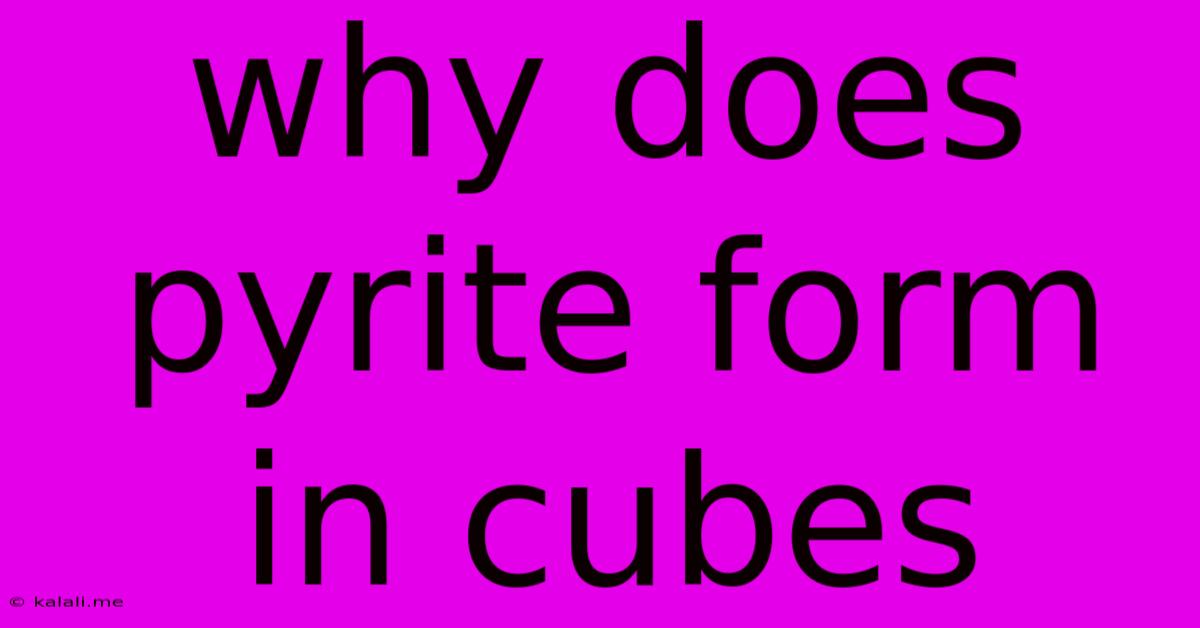Why Does Pyrite Form In Cubes
Kalali
Jun 11, 2025 · 3 min read

Table of Contents
Why Does Pyrite Form in Cubes? Understanding the Crystal Structure of Fool's Gold
Pyrite, also known as fool's gold due to its brassy yellow color, is famous for its striking cubic crystals. But why does this iron sulfide mineral so often adopt this specific shape? The answer lies in its unique crystal structure and the way its constituent atoms arrange themselves during formation. This article will delve into the fascinating world of crystallography to explain the cubic habit of pyrite.
Understanding Crystal Structure and Habit
A mineral's crystal structure refers to the three-dimensional arrangement of its atoms, ions, or molecules. This arrangement is governed by the chemical bonding between the constituent particles, and it dictates many of the mineral's physical properties, including its shape, or crystal habit. While many minerals exhibit a variety of crystal habits depending on the growth conditions, pyrite famously exhibits a strong preference for cubic structures.
Pyrite's Cubic Crystal Structure: A Closer Look
Pyrite's chemical formula is FeS₂ (iron disulfide). The iron (Fe) atoms and disulfide ions (S₂) arrange themselves in a specific three-dimensional lattice. This lattice is characterized by a cubic unit cell – the smallest repeating unit that builds up the entire crystal. Within this cube, each iron atom is surrounded by six sulfur atoms, and each sulfur atom (in the disulfide anion) is bonded to one iron atom.
This highly ordered arrangement dictates the macroscopic cubic shape observed in many pyrite crystals. The strong, directional bonds between the iron and sulfur atoms influence the crystal growth, favoring the formation of planes that ultimately define the cubic faces.
Factors Influencing Pyrite Crystal Growth
While pyrite's intrinsic crystal structure predisposes it to cubic form, other factors influence the final crystal habit. These factors include:
- Growth Rate: Slow, steady growth allows for the development of well-formed, perfect cubes. Faster growth can result in less well-defined crystals or other habits.
- Space Availability: Ample space allows crystals to grow freely, promoting the formation of well-defined cubes. Constrained growth, for example, in a tight cavity, can lead to distorted or intergrown crystals.
- Impurities: The presence of impurities in the solution from which pyrite crystallizes can also influence crystal habit. These impurities can interfere with the regular arrangement of atoms, leading to deviations from perfect cubic form.
- Temperature and Pressure: These conditions during crystallization also influence crystal growth. Changes in temperature and pressure can alter the rate of crystal growth and the stability of different crystal faces.
Variations in Pyrite Crystal Habits
While cubic crystals are the most common, pyrite can also exhibit other habits, including:
- Octahedral: These are eight-sided crystals, related to the cubic form.
- Pyritohedral: These are more complex crystals with 12 pentagonal faces.
- Massive: In some cases, pyrite occurs as an aggregate of tiny crystals forming a massive, non-crystalline appearance.
These variations often result from variations in the growth conditions discussed above.
Conclusion:
The cubic habit of pyrite is a direct consequence of its inherent crystal structure, specifically the arrangement of iron and disulfide ions within a cubic unit cell. While the underlying crystal structure is the primary factor, the growth conditions, including rate, space availability, impurities, and temperature/pressure, significantly influence the final crystal shape and perfection. Understanding these aspects provides a deeper appreciation for the beauty and complexity of this fascinating mineral.
Latest Posts
Latest Posts
-
What Is The Biggest Ecosystem On Earth
Jun 12, 2025
-
Isotopes Are Atoms That Have
Jun 12, 2025
-
How To Calculate Modulus Of Resilience
Jun 12, 2025
-
This Body Of Water Divides Europe And North Africa
Jun 12, 2025
-
New York University Average Sat Score
Jun 12, 2025
Related Post
Thank you for visiting our website which covers about Why Does Pyrite Form In Cubes . We hope the information provided has been useful to you. Feel free to contact us if you have any questions or need further assistance. See you next time and don't miss to bookmark.